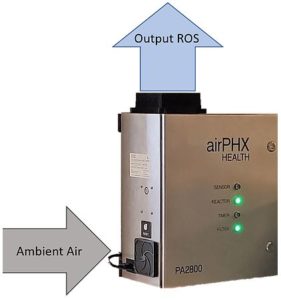A proactive way to reduce pathogens & HAI's
The World Health Organization reports that HAIs prolong hospital stays, create long-term disability, increase resistance to antimicrobials, place a massive financial burden on health systems, generate high costs for patients and families, and lead to unnecessary deaths. Although significant progress has been made in preventing some healthcare-associated infection types, there is much more work to be done. On any given day, about one in 31 hospital patients has at least one healthcare-associated infection.
Primary Systems provides a solution that is 100% organic and is designed to operate 24/7 – use little electricity, and requires no manual labor, chemicals, or bulb replacement. Our clean air passive technology has been tested to confirm rapid elimination of 35 common HAI pathogens on surfaces including stainless steel, plastic, and linoleum floors. First, airborne pathogens are destroyed as air circulates through the unit, then, air containing oxidizing molecules circulate in the treatment space. Organisms are eliminated in the air and surfaces throughout the room. This results in reduction of HAI risk, readmission risk, litigation cost and exposure, and reputational risk.
Primary Systems will provide validation services to confirm effectiveness after the solution is implemented within your facility. Our validation process provides quantified results to support reporting, marketing, and risk management objectives.
airPHX Reduces CLABSI HAI by 50%, Saving Hospital System $1,000,000
Organisms Evaluated & Mitigated
- Acinetobacter baumannii
- Bacteroides fragilis
- Burkholderia cepacia
- Clostridium difficile
- Clostridium sordellii
- Carbapenem-resistant
- Enterococcus faecalis
- Escherichia coli
- Escherichia coli O157:H7
- Listeria monocytogenes
- Salmonella spp
- Methicillin-resistant Staphylococcus aureus
- Mycobacterium tuberculosis
- Klebsiella pneumoniae
- Psuedomonas aeruginosa
- Staphylococcus aureus
- Vancomycin-resistant Staphylococcus aureus
- Vancomycin-resistant Enterococci
- Hepatitis A
- Hepatitis B
- Hepatitis C
- H1N1
- Influenza A
- Norovirus
- Blastocystis hommis
- Cryptosporidium parvum
- Giardia lamblia
- Cyclospora cayetanensis
- Toxoplasma gondii
- Entamoeba histolytic
Comparing Technology
Others Technology
- UV-C Treatment– effectiveness limited to pathogens passing through UV-C emission; limited range and ineffective treating around shadows; not cost effective; UV bulb deteriorates; does not remove allergens from air; direct exposure to UV-C light is harmful to people; Over time, DNA/RNA can become resistant to UV-C treatment.
- Chemicals– (hydrogen peroxide, bleach)- kill pathogens on surfaces; labor intensive to apply; not continuous; potentially corrosive to equipment; does not treat air.
- HEPA Filtration– moderately effective on dust, pollen, mold spores; does not remove chemical fumes, smoke or odors; organisms captured in filter can breed or reproduce; does not kill pathogens.
- Photocatalytic Oxidation– exposes UV light to a catalyst like titanium dioxide; requires UV light to operate; found to kill pathogens in a laboratory; not cost effective; killing effect limited to what passes through the device; can produce high levels of ozone.
- Ionizers– built around a negative ion generator; removes particles from the air but not from the room (they settle on floors, walls, and furnishing and can be recirculated); produces ozone as a byproduct; does not remove odor; some can provide sterilization but only via high ozone levels.
- Ozone– corrosive to equipment and surfaces: irritates throat and lungs; effective, but only at levels deemed hazardous by EPA.
Our Technology
- Low maintenance – No FTE
- Non-corrosive
- Continuous operation without aggravating people
- Tested effective against a large number of pathogens
- Effective on surfaces, air & spaces (treating everywhere that the treated air touches)
- Inexpensive operating costs
- Kills pathogens
- Removes VOC’s, odors, and smoke
- Treats 100,000-150,000 cubic feet of air and surfaces

